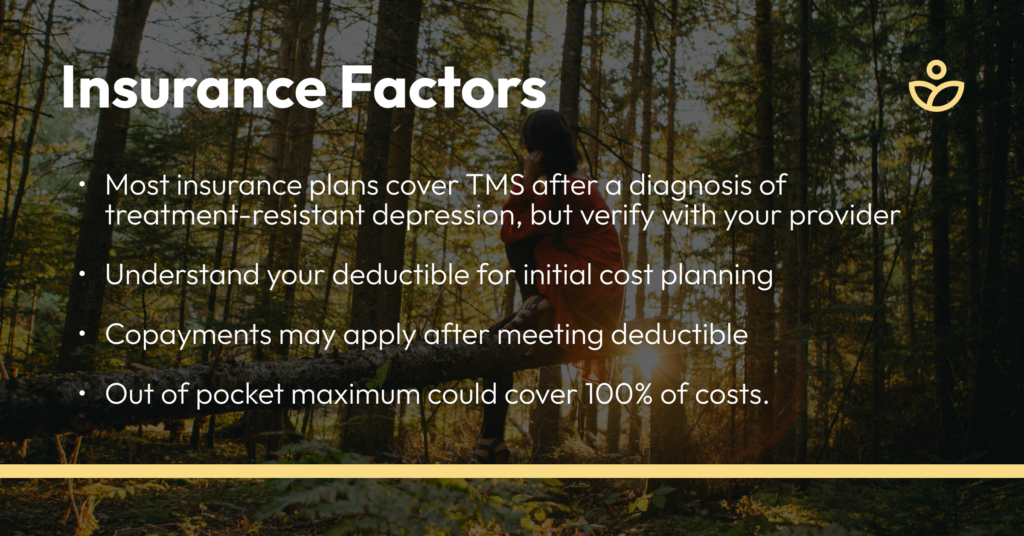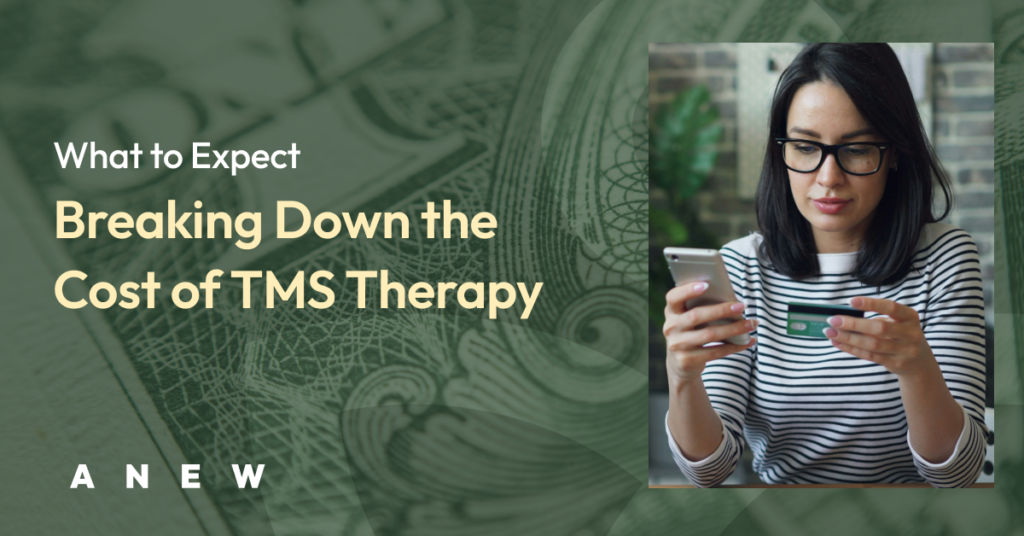Transcranial magnetic stimulation (TMS) therapy cost is a crucial consideration for many seeking relief from depression. This non-invasive treatment offers a guide of hope for those who have found little success with traditional approaches. Understanding the financial commitment involved is key. Typically, a single TMS session costs between $300 and $500, with a complete treatment course ranging from $6,000 to $15,000 depending on the number of sessions. However, most insurance plans cover TMS after a diagnosis of major depressive disorder (MDD) or obsessive-compulsive disorder (OCD), so the cost to the patient usually comes down to their copay (typically between $10 and $50 per session).
- Out of Pocket Cost: Most insurances cover TMS, with average copays ranging between $10-50 per session
- Number of Sessions: 36 sessions is the standard treatment course. This means patients with insurance can expect to pay between $360-$1800 for the whole series.
- Treatment duration: Each session is 20-30 minutes, with no downtime. It is standard for patients to come in 4-5 times per week for around 8 weeks to receive treatment.
At Anew Therapy, located in Sandy, Utah, we recognize that depression can take both an emotional and financial toll. We’re committed to helping you find relief through cost-effective, non-invasive treatments that put your well-being first. In addition to TMS, we also offer IM ketamine therapy and Spravato (an esketamine nasal spray)—often covered by insurance—so you can receive the support you need without added stress.
Understanding TMS Therapy Cost
When considering TMS therapy cost, it’s important to look at several factors that can influence the price. These factors include location, insurance coverage, session frequency, and treatment duration. Let’s break these down to give you a clearer picture.
Factors Influencing TMS Therapy Cost
- Location: Where you receive TMS therapy can greatly affect the cost. Prices vary from one region to another, and urban areas might have higher costs due to increased demand and operational expenses.
- Insurance: Coverage can significantly reduce your out-of-pocket expenses. It’s important to check with your provider to see if TMS is covered under your plan, especially since it is often approved for major depressive disorder (MDD) or obsessive-compulsive disorder (OCD).
- Session Frequency and Treatment Duration: Typically, a complete TMS treatment course involves 20 to 30 sessions. The number of sessions you need will depend on your specific condition and how you respond to treatment.
TMS Therapy Cost with Insurance
Insurance can play a pivotal role in managing the financial investment required for TMS therapy. Here’s what to consider:
Copayments and Out-of-Pocket Maximum: After meeting your deductible, you may still have copayments for each session. Once you reach your out-of-pocket maximum, your insurance may cover 100% of the costs.each session. Once you reach your out-of-pocket maximum, your insurance may cover 100% of the costs.
Coverage: Although most major insurance companies cover TMS for major depressive disorder and OCD, coverage can vary, so it’s crucial to verify with your insurance provider.
Deductible: This is the amount you pay out-of-pocket before your insurance kicks in. Understanding your deductible helps you plan for initial costs.

At Anew Therapy in Utah, we strive to make TMS therapy as accessible as possible. Our experienced team works with insurance companies to minimize financial burdens for our patients. Insurances we accept include:
- Aetna
- Blue Cross Blue Shield
- Cigna
- United Healthcare
- DMBA
- EMI health
- Medicare
- Select Health
Additionally, we offer Spravato, an esketamine nasal spray, and IM ketamine therapy, which are often covered by insurance and provide effective treatment options for depression. We believe in providing effective treatment options without overwhelming costs.
In the next section, we’ll compare TMS therapy with other treatment options, helping you make an informed decision about your mental health care.
Comparing TMS Therapy with Other Treatments
When it comes to treating depression, you have several options to explore. TMS therapy, Spravato (esketamine nasal spray), and ketamine therapy each bring unique advantages to the table. The right choice will depend on factors like your specific symptoms, personal preferences, and how quickly you want to see results.
TMS Therapy vs. Spravato
TMS Therapy uses magnetic pulses to stimulate the areas of the brain responsible for mood regulation. It’s FDA-approved for major depressive disorder and anxious depression, and it’s often covered by insurance. A typical course involves around 36 sessions over several weeks, each lasting 20–30 minutes with no recovery period required.
Spravato is an esketamine nasal spray also FDA-approved for major depressive disorder as well as treatment-resistant depression. It delivers rapid relief through a chemical pathway and is administered under medical supervision. Insurance coverage for Spravato can be favorable, making it accessible to many patients who need faster symptom relief.
- Treatment Approach: TMS uses magnetic pulses to stimulate mood-regulating areas of the brain, while Spravato (esketamine nasal spray) delivers a rapid chemical effect to relieve depression symptoms. Both approaches are non-invasive and FDA-approved for treating depression.
- Insurance Coverage: TMS and Spravato are both frequently covered by insurance, though specifics vary by plan and provider. Check with your insurance company to determine exact coverage and out-of-pocket costs.
Combining TMS and Spravato
In many cases, patients may benefit from using TMS and Spravato together. Research suggests that combining esketamine with TMS can yield more robust and long-lasting improvement in symptoms. This dual approach targets both the electrical and chemical pathways implicated in depression, potentially providing a comprehensive solution for those who have struggled with other treatments.
TMS Therapy vs. Ketamine Therapy
Both TMS therapy and ketamine therapy offer unique benefits:
- TMS Therapy:
- Non-invasive and typically well-tolerated with minimal side effects.
- Provides gradual, steady improvement over several weeks.
- Commonly covered by insurance for major depressive disorder (MDD).
- Ketamine Therapy:
- Known for rapid relief of depressive symptoms—especially the IM (intramuscular) approach used at Anew Therapy.
- Often part of a holistic treatment plan that includes psychotherapy and supportive care.
- Insurance coverage can be less predictable, leading many to use financing options like CareCredit.
If you’re seeking a gradual, non-invasive option, TMS may be appealing. For those in acute distress who need fast-acting relief, ketamine therapy can be a strong alternative. The choice largely depends on your individual needs, the severity of symptoms, and insurance considerations.
Conclusion
At Anew Therapy Utah, we are dedicated to providing patient-centric care, understanding that mental health is a crucial investment in your overall well-being. Our approach is holistic and custom, ensuring that each patient receives the most effective treatment for their unique needs.
When it comes to treatment options, we offer a variety of therapies, including Spravato, ketamine therapy, and TMS therapy. Each of these treatments has its own benefits and can be an important part of your mental health journey. Whether you’re looking for the rapid relief from Spravato, the holistic benefits of ketamine therapy, or the non-invasive nature of TMS, we are here to guide you through the decision-making process.
Spravato and ketamine therapy are excellent choices for those in need of fast-acting relief. These treatments are often favored for their quick onset and are part of our comprehensive care strategy. Additionally, Spravato is often covered by insurance, making it an accessible option for many patients. However, if you’re seeking a non-invasive and insurance-friendly option, TMS therapy is a proven method for those who have not found success with traditional antidepressants.
For more information about TMS treatment at Anew Therapy, visit our TMS Therapy page.
Your mental well-being is our priority, and you don’t have to face this journey alone. We’re here to walk alongside you, offering support and solutions every step of the way.

Searching for the best TMS clinic in Utah? Anew Therapy offers expert care and proven results. Schedule your free intake appointment today.

